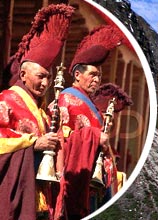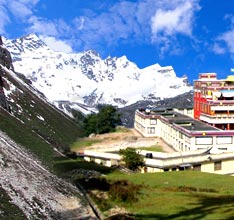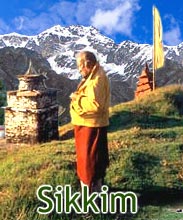 Sikkim
has an interfusion of diverse communities, cultures, religions and
customs. Sikkim is a fine specimen of harmony between people from
different areas and regions. The people of Sikkim are known as
Sikkimese. In Sikkim, the leading communities are the Lepchas, Bhutias
and Nepalese. However, the municipal areas are dominated by the
plainsmen, who have settled there, owing to their businesses and
Government services. The developmental activities in Sikkim like
construction of roads, bridges, buildings etc, have informally invited
migrant laborers from the plains and Nepal. In the following lines, we
will discuss the three cultural communities and their lifestyle in
detail.
Sikkim
has an interfusion of diverse communities, cultures, religions and
customs. Sikkim is a fine specimen of harmony between people from
different areas and regions. The people of Sikkim are known as
Sikkimese. In Sikkim, the leading communities are the Lepchas, Bhutias
and Nepalese. However, the municipal areas are dominated by the
plainsmen, who have settled there, owing to their businesses and
Government services. The developmental activities in Sikkim like
construction of roads, bridges, buildings etc, have informally invited
migrant laborers from the plains and Nepal. In the following lines, we
will discuss the three cultural communities and their lifestyle in
detail.The Lepchas
The Lepchas are said to be the original inhabitants of Sikkim. They used to reside in Sikkim, long before the migration of Bhutias and Nepalese. The original Lepchas were believers of the bone faith or mune faith. The faith was essentially based on spirits, good and bad. They used to worship spirits of mountains, rivers and forests. Perhaps, this could be the reason why these people prefer to live in the healthy natural world.
Constituting only 13% of the total population of Sikkim, Lepchas are concentrated in the central part of Sikkim. Lachen, Lachung River and Dickchu are the prominent places of Lepchas. The Lepchas have a very simple lifestyle. The males wear a dress known as 'Pagi', a cotton dress in strips. The females sport a two piece dress. They speak 'lepcha' language, which is not very popular in the state. These people are really good at archery.
The Bhutias
The Bhutias are people of Tibetan origin. After the 15th century, these people migrated to Sikkim. The northern part of Sikkim is basically inhabited by the Bhutias. These people speak 'Sikkimese' language. If compared with the Lepchas, the Bhutias are dominating large number of villages. The rectangular shaped house of a 'Bhutia' is known as 'Khin'.
The males wear a dress known as 'Bakhu', which is actually a loose cloak form garment with full sleeves. The females wear a silken 'Honju' that is a full sleeve blouse with a loose gown type garment. The Bhutia ladies love wearing heavy jewelry made of pure gold. Sikkim has its religion incorporated with Bhutias. Constituting around 16% of the total population of Sikkim, Bhutias regard priesthood as their academic as well as spiritual choice.
The Nepalese
In Sikkim, the Nepalese came long after the Lepchas and Bhutias. They migrated to Sikkim in huge numbers and rapidly, emerged as the leading community. In the present day, the Nepalese constitute 67% of the total population of Sikkim. These people commenced terrace farming in the state. Cardamom is an important cash crop that was cultivated by the Nepalese. The Nepalese are sub-divided into various castes and tribes like Bawans (Brahmans), Chhetries, Gurungs, Tamangs, Rais, Limbus, Magars, Damais, Kamis etc.
The majority of their population follows Hinduism, whereas Buddhism is also practiced by some groups. These people speak language that is similar to Hindi and is understood throughout the state of Sikkim. The traditional Nepali dress for males comprises a long double breasted garment flowing below the waist along with a trouser known as 'Daura Suruwal'. The traditional dress for females comprises of a double breasted garment known as 'Chow Bandi Choli'. The shawl wore by them is known as 'Majetro'. 'Khukri' is a heavy weapon that is carried in a wooden or leather case known as "Daab".








